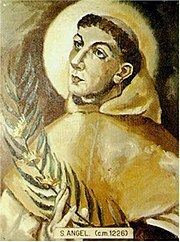Feast May 5 Major shrine Licata Died 1220, Licata, Italy | Role Saint Name Angelus Jerusalem | |
 | ||
Canonized 15th century by Pius II Attributes , sword through chest, book, palm, three crowns, lilies, roses | ||
St. Angelus of Jerusalem in Hindi | 5 May | Christian Saints in Hindi | Atmadarshan TV
Saint Angelus (Italian: Sant'Angelo) (1185–1220) was a saint and martyr from the Holy Land.
Contents
- St Angelus of Jerusalem in Hindi 5 May Christian Saints in Hindi Atmadarshan TV
- Life
- Veneration
- References
Life
Angelus was born in Jerusalem to a Jewish family. His mother, however, converted to Christianity, and Angelus, along with his twin brother, John, was baptised when she converted. His parents died while he was young, and he and his twin brother entered the Carmelite Order at the age of eighteen. They already spoke Greek, Latin, and Hebrew.
Around his twenty-sixth year, Angelus was ordained in Jerusalem, and he traveled through Palestine. Various miraculous cures were attributed to him. His acta states that he sought to avoid fame, and when he was becoming known for his miracles, he withdrew from society to a hermitage. He remained a hermit on Mount Carmel until he was instructed to leave for Italy to preach against Albigensians, Bulgars, and patarini.
He went to Sicily, and his fame as a miracle-worker caused crowds to come to him.
He wanted to convert a Cathar knight named Berenger (Berengarius). Catholic tradition states that Berenger was living in incest and that Angelus convinced the knight's companion to leave Berenger. Berenger became enraged and killed or had him killed in front of the Church of SS. Filippo e Giacomo in Licata. He died of his wounds four days after the attack, and according to Catholic tradition, asked for his assassin to be pardoned. He was buried at SS. Filippo e Giacomo.
Veneration
His sepulcher at Licata became a site of pilgrimage. The Carmelites venerated him as a saint from at least 1456 and the cult was approved by Pope Pius II. His relics were translated to a new church in Licata, S. Maria del Carmine; the ending of a plague in the Kingdom of Naples in 1656 was attributed to his intercession.
